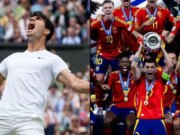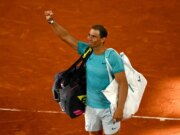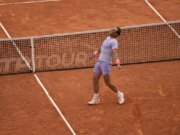The seizure by M23 rebels of vast tracts of land in the mineral-rich east of the Democratic Republic of Congo has triggered a humanitarian and diplomatic crisis, involving several neighbouring countries.
An alarming number of African countries already have troops deployed in the conflict zone, which has a long history of outside interference.
The DR Congo is such a vast country – two-thirds the size of Western Europe – that it is a member of both the East and Southern African blocs.
The two regional groupings are joining forces to hold an emergency summit on Saturday to try and end the fighting.
So, who are the main players and what do they want?
Democratic Republic of Congo – ‘The besieged giant’

DR Congo President Félix Tshisekedi says his country has been invaded [Getty Images]
First and foremost is the Congolese President Félix Tshisekedi. He wants to regain territory lost to the rebels, including the largest eastern town of Goma, and to prevent them from seizing more.
He blames Rwandan leader Paul Kagame for backing the M23 with weapons and troops, accusing Kigali of invading Congolese territory with the aim of looting the country’s mineral wealth and orchestrating regime change.
The case that Rwanda is supporting the M23 offensive is based on evidence presented in a UN report and broadly accepted by many African and Western governments, who have demanded that Kagame withdraw his forces.
However, to Tshisikedi’s frustration, none have matched their rhetoric with action and responded to Kinshasa’s calls for sanctions and other tough measures.
The Congolese leader is also worried about keeping his seat.
“I think the political survival of his government is at stake,” said Jason Stearns, a former UN investigator in DR Congo and currently a professor at Simon Fraser University.
There is concern that the M23 campaign might embolden internal opposition forces or trigger a coup in his army, which has a reputation for being fragmented and undermined by corruption.
Rwanda – ‘The elusive player’

Rwanda’s President Paul Kagame says he is fighting genocidal militias [Reuters]
In this conflict, Rwanda’s long-time leader Kagame is the centre of attention, but he’s practised at deflecting it.
He has a long history of military intervention inside DR Congo linked to the aftermath of the 1994 Rwanda genocide.
Rwanda does not admit to providing military support to the M23, but repeatedly insists it will do anything necessary to defend itself.
Kagame maintains that Rwanda’s priority is to destroy an armed group formed by the Hutu genocide perpetrators, who massacred Rwandan Tutsis and then fled to what is now eastern DR Congo.
He has accused DR Congo’s army of joining forces with them and others to not only slaughter Congolese Tutsis – who the M23 claims to be fighting to protect – but to threaten Rwanda.
At a diplomatic level, Rwanda wants confirmation of its narrative – that the conflict is a Congolese problem, and Kigali is simply defending its borders against the spill-over of a civil war.
It’s demanding that Kinshasa negotiate directly with the M23, which it refuses to do.
But what it’s really after, said Mr Stearns, is “to maintain a sphere of influence in the eastern DR Congo”.

Friends and relatives watch as those who were killed when the M23 captured Goma are buried in fresh graves [AFP]
Rwanda has economic as well as security interests.
Kigali denies UN evidence that it smuggles vast amounts of gold and other metals out of eastern DR Congo and sells them as its own. But access to DR Congo’s mineral wealth has been a driver of conflict in the region for decades.
There are others this time around, not least the personal animosity between Kagame and Tshisekedi.
“Kagame wants to teach Tshisekedi a lesson about who’s the strong guy on the block,” said Richard Moncrieff, who monitors Africa’s Great Lakes region for the International Crisis Group (ICG).
The Rwandans are “just going to keep fighting until he makes concessions and…gives them fairly free rein in [the eastern province of] North Kivu,” he added.
Burundi – ‘The watchful neighbour’

Burundi’s President Evariste Ndayishimiye has had a tense relationship with Rwanda’s Kagame for years [Getty Images]
Rwanda sees Burundi’s army as another security threat in eastern DR Congo.
The nation that borders both Rwanda and DR Congo has had thousands of soldiers there for years. They went to hunt down Burundian rebels but are now supporting Kinshasa’s army in battles against the M23.
Relations between Rwanda and Burundi are hostile. The two countries have a similar ethnic make-up but unlike Rwanda, the majority Hutus are in power in Burundi. Both countries have accused each other of trying to overthrow their respective governments.
Burundi’s President Evariste Ndayishimiye has posted a strongly-worded warning on social media.
“If Rwanda continues to make conquests,” he wrote, “I know that war will even arrive in Burundi… One day he [Kagame] wants to come to Burundi – we’re not going to accept that. The war will spread.”
The threat would increase if the M23 continues its advance from Goma into the province of South Kivu closer to Burundi’s border, which is where its forces are stationed.
“What Burundi is seeking here is regime survival,” said Mr Stearns.
“Burundi is worried that if Rwandan troops… extend their influence into South Kivu that could destabilize the government in Bujumbura. What’s at stake here is stopping this rebellion before it gets too close to home.”
Some fear a repeat of the two wars that engulfed the region in the late 1990s, which drew in nine different countries and reportedly led to millions of deaths.
This time, direct clashes between the two armies could extend the DR Congo’s conflict beyond its borders.
Uganda – ‘Playing it both ways’

Uganda’s President Yoweri Museveni has been accused of playing both sides [Getty Images]
Uganda is not directly involved, but it also has troops in eastern DR Congo.
They are helping the Congolese government with a different security threat – hunting down militants with Ugandan origins who are connected to the Islamic State group.
But Uganda’s role is confusing – it’s working with the Congolese, while also allegedly providing at least complicit support to the M23. UN experts report that it has allowed them to use Ugandan territory as a rear base and supply route.
Kampala strongly denies that. But it has responded to the M23 offensive by putting its troops in a “forward defensive posture,” to prevent other armed groups from exploiting the crisis, it has said.
Local residents have reported seeing Ugandan soldiers moving towards the conflict zone, heightening fears of a regional escalation.
Like Rwanda, Uganda has entered eastern DR Congo in the past claiming to be protecting its borders. But it’s also accused of looting natural resources, especially gold.
Analysts expect it to safeguard its economic interests while keeping an eye on the Rwandans.
“It’s very clear that Uganda wants to retain its own influence in eastern DR Congo and not be pushed out by its rival in Rwanda,” says the ICG’s Mr Moncrieff.
South Africa – ‘The peacekeeper taking sides’

President Cyril Ramaphosa found himself in a heated online back-and-forth with Rwanda leader Paul Kagame over the crisis in DR Congo [Getty Images]
South Africa has contributed most of the troops to a Southern African regional force fighting alongside the Congolese army and has suffered heavy losses.
But it’s also been thrust into the headlines because of an astonishingly vitriolic exchange between Kigali and Johannesburg.
The South Africans blamed the deaths of 14 of their soldiers on the Rwandan Defense Forces, which President Cyril Ramaphosa disparagingly referred to as the “RDF militia.”

Congolese people in South Africa have been protesting against the conflict in their country for decades [AFP]
His defence minister claimed he’d warned Kagame that any further shooting would be taken as a declaration of war.
This infuriated the Rwandan president, who said that the account of their conversation was a “lie” and called the South Africans a “belligerent” force that must leave the DR Congo.
This is the sharpest end of a broad division between the East African Community (EAC) and the Southern African Development Community (Sadc).
The EAC supports Rwanda’s call for direct talks between Kinshasa and the M23.
While Sadc condemns RDF attacks on its soldiers, including Tanzanian and Malawian troops, and has reaffirmed their commitment to DR Congo’s independence, sovereignty, and territorial integrity.
More BBC stories on the conflict in DR Congo:

[Getty Images/BBC]
Go to BBCAfrica.com for more news from the African continent.
Follow us on Twitter @BBCAfrica, on Facebook at BBC Africa or on Instagram at bbcafrica







